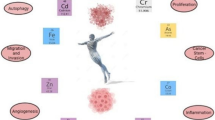Abstract
Data concerning the blood selenium level and its relation to the mortality from lung cancer are reported. There were 353 samples of blood collected from workers at the Yannan Tin Mine (Yun-Xi) and 75 samples from Beijing residents for comparison. An inverse correlation between blood selenium levels and lung cancer mortalities was observed. The average selenium concentration in whole blood from Beijing residents (age-adjusted mortality rate from lung cancer for males: 12/100,000) and Yun-Xi miners (age-adjusted mortalty from lung cancer for males: 108/100,000) were 12.3 and 8.8 μg/100 mL, respectively. A similar inverse correlation was also observed among young people of comparable sex and age groups. In Yun-Xi, the tin miners working underground with an average lung cancer death rate of 250/100, 000 for males had lower blood selenium concentrations than those working above ground, where the average lung cancer death rate for males was 42/100,000. Workers frequently exposed to arsenic exhibited lower blood selenium contents. Selenium levels in the blood of patients with lung cancer were lower (6.2 μg/100 mL) than those of healthy controls.
Similar content being viewed by others
References
R. J. Shamberger and D. V. Frost,Can. Med. Assoc. J. 100, 682, (1969).
R. J. Shamberger, S. A. Tytko, and C. E. Willis,Arch. Environ. Health 31 231 (1976).
G. N. Schrauzer, D. A. White, and C. J. Schneider,Bioinorg. Chem. 7, 36 (1977).
R. J. Shamberger, E. Rukavena, A. K. Longfield, S. A. Tytko, S. Deodhar, and C. E. Willis,J. Nat. Cancer. Inst. 50, 863 (1973).
W. L. Broghamer, Jr., K. P. McConnell, and A. L. Blotcky,Cancer 37, 1384 (1976).
C. C. Y. Chan,Anal. Chim. Acta 82, 213 (1976).
O. A. Levander and C. A. Baumann,Toxicol. Appl. Pharmacol. 9, 106 (1966).
G. N. Schrauzer, D. A. White, J. E. McGinness, C. J. Schneider, and L. J. Bell,Bioinorg. Chem. 9, 245 (1978).
G. N. Schrauzer, “Trace Elements in Carcinogenesis”, inAdvances in Nutritional Research, Vol. 2, (H. H. Draper, ed.), Plenum, 1979, pp. 219–244, and references cited therein.
J. L. Greger, S. Å. Smith, M. A. Johnson, and M. L. Baier,Biol. Trace. Elem. Res. 4, 269 (1982).
Author information
Authors and Affiliations
Rights and permissions
About this article
Cite this article
Chu, YJ., Liu, QY., Hou, C. et al. Blood selenium concentration in residents of areas in China having a high incidence of lung cancer. Biol Trace Elem Res 6, 133–137 (1984). https://doi.org/10.1007/BF02916930
Received:
Accepted:
Issue Date:
DOI: https://doi.org/10.1007/BF02916930




